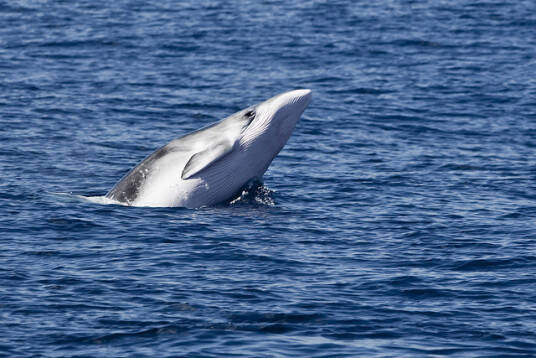Balaenoptera bonaerensis
IUCN
LCBasic Information
Scientific classification
- name:Balaenoptera bonaerensis
- Scientific Name:Antarctic baleen whale, Southern minke whale
- Outline:Cetacea
- Family:B.whales
Vital signs
- length:7.2-10.7m
- Weight:5.8-9.1 tons
- lifetime:About 50 years
Feature
One of the smallest baleen whales
Distribution and Habitat
Antarctic minke whales are found in the oceans of the Southern Hemisphere. They are closer to the Antarctic in the summer and migrate northward in the winter, overlapping with the habitat of pygmy minke whales.
Main distribution area: Antarctica.
Main distribution countries: Argentina, Australia, Brazil, Chile, France (French Southern Hemisphere Territories), New Zealand, Peru, South Africa, South Georgia Island and the South Sandwich Islands, Uruguay.
Appearance
The Antarctic Minke Whale is one of the smallest baleen whales. Among the baleen whales, only the pygmy whale is smaller. It is 7.2-10.7 meters long and weighs 5.8-9.1 tons. On average, females are about 1 meter longer than males. The calves are 2.4-2.8 meters long.
The back is dark gray and the belly is white. There are two light gray stripes on the belly that extend up the sides. The pectoral fins are dark with white edges.
There are many differences between the Antarctic Minke Whale and the Pygmy Whale. The Antarctic Minke Whale is slightly larger than the Pygmy Whale, and the Pygmy Whale has a white stripe in the middle of its pectoral fin. There are also some differences in their external color and body shape.
Details
Antarctic minke whale (scientific name: Balaenoptera bonaerensis) is also known as Antarctic minke whale. New mitochondrial DNA tests have found that Antarctic minke whales are independent species from minke whales. This test also determined that minke whales are the closest relatives of Antarctic minke whales, so the Antarctic minke whale branch is valid. Among the baleen whales, only minke whales are smaller than them.

Antarctic minke whales hunt alone or in groups. A hunting group consists of 2-4 individuals, and the group members are relatively free to move. Compared with open waters, they seem to gather more in closed territories. In order to open a vent in the ice, Antarctic baleen whales often use their beaks to break through a few centimeters of ice. The distance between two adjacent vents on the ice is generally 200-300 meters. It is said that this species jumps on the water surface to avoid hitting sailing ships. However, they are also notorious for their curiosity. As the type of baleen whale that most frequently approaches anchored ships, their escape behavior is not as common as being found on floating ice. Antarctic baleen whales swim fast and can accelerate to 20 kilometers per hour. Generally, they dive for 2-6 minutes, stay on the water for one minute, breathe 5-8 times, and dive for up to 20 minutes. The most unusual thing about them compared to other baleen whales is that most Antarctic minke whales migrate in summer and winter, and a few stay in Antarctic waters all year round.
Like the pygmy whale, the Antarctic minke whale has a gestation period of 10 months, and then gives birth to a 2.7-meter-long calf. The calves stay with their mothers for up to 2 years, nursing for 3 to 6 months. In the 1950s to 1970s, surveys of a group of the same age group found that they reached sexual maturity at a younger age, from an average of 11 years to about 7 years. Female whales are responsible for the birth, care and protection of the calves, and males do not provide parental care. Like their close relatives, minke whales, the milk of mother whales contains lactose and several oligosaccharides, some of which have never been found in other mammals, which can enhance the immunity of newborn whales.
The World Conservation Union (IUCN) lists the Antarctic minke whale as a "data deficient" species. However, there is evidence that their population has declined by about 60% between 1978 and 2004. If this decline is temporary, they will be classified as a "low-risk species", and if it is an actual decline, they will be classified as "endangered species". The projected significant decline in Antarctic sea ice extent could significantly affect krill populations and Antarctic minke whale populations that rely on krill for food. The last official count of Antarctic minke whales was completed in the 1980s, when the population was 860,000. As of 2007, there may be only 430,000 Antarctic minke whales left.
Listed in the 2021 IUCN Red List of Threatened Species ver 3.1 - Near Threatened (NT).
Protect wildlife and eliminate game.
Maintaining ecological balance is everyone's responsibility!








